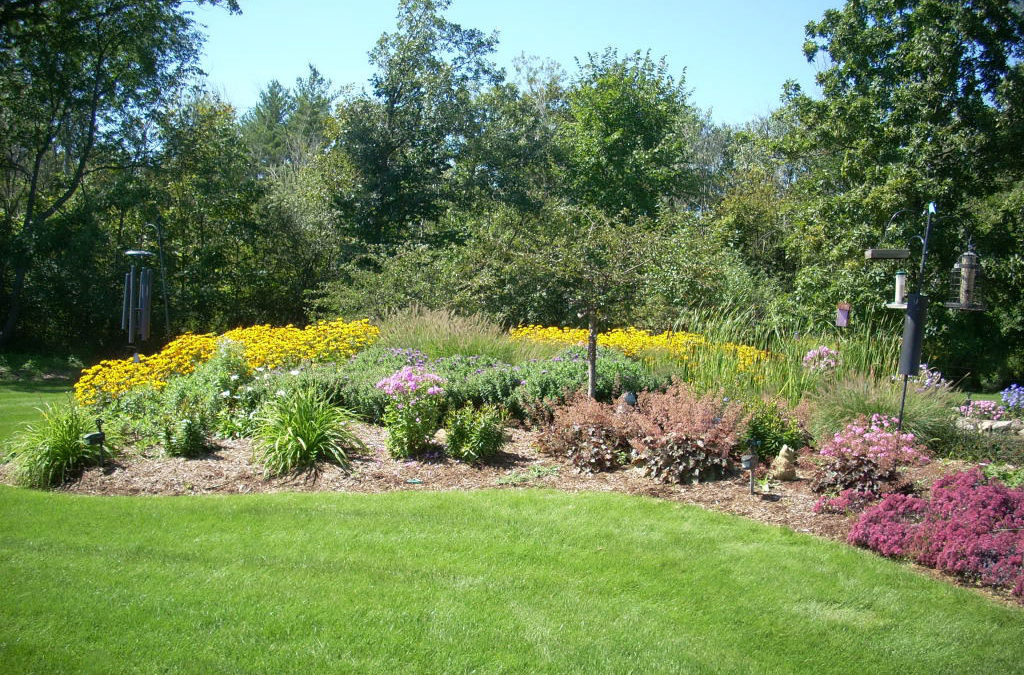Small flowerbeds can make a big statement! If you want to make your small home garden turn heads, some simple techniques produce big results. Landscape designers follow some tried and true methods to produce colorful and attention-grabbing lawns and gardens. Here’s a flowerbed planting idea from Createscape Landscaping Service that will make your neighbors think you are a master gardener.
Plant Groupings
One professional-level flowerbed planting technique is plant groupings. This method involves installing several different plants together in small, tight groupings in a specific arrangement. The technique combines two elements to accomplish the final look: flower color and plant height.
The plants should be installed closely together, with virtually no space between them. And each plant variety should be kept together, as opposed to mixing all the plants randomly. The concept is to create an orderly pattern with each plant variety. The outside rim will have the shortest plant variety of one color. The next tier inside will have a medium-height plant in a different color, and the plant in the center will be the tallest and a different color than the others. The result should be a collection of plants rising from shortest to tallest in sections with each color together.
How to Create a Plant Grouping
To achieve this design, start with determining the colors you most enjoy and which of those colors will go well together. For example, a plant grouping could include flowers in red, orange, yellow, and purple. To best accomplish this design, limit the number of flower colors to three or at most four.
The next step is to choose plants in your selected colors with two considerations – height and hardiness. Let’s explore the height criteria first.
For the increased height plan to work, start with a ground cover plant, or one that grows to at most six inches tall. For example, the Dragons Blood Sedum grows only 4 to 6 inches tall and produces vivid red flowers in late summer.
Next, choose a medium-height plant – one that is taller than the ground-cover plant. Some options include the Yellow Coreopsis, which reaches a height of 12–14 inches with golden yellow flowers, or Marigolds that grow from 6 to 36 inches tall depending on the breed.
Finally, choose your center plant, which should be the tallest and most eye-catching flower. Great choices include Salvia and Lavender. These plants have long stems with purple flowers that wave in the wind and draw your attention.
How to Ensure a Successful Plant Grouping
Now let’s explore the hardiness of the plants. The plants you choose should have key things in common. Depending on the location of your flowerbed, they should all have the same sun and heat tolerance. They should also have similar watering requirements and tolerance to the soil moisture level. Some qualities of the plants you choose may include resistance to deer and rabbits, or attraction of bees and butterflies. Before you purchase the plants, do some quick research to confirm how well their growing needs match to ensure they will grow well together in the same location.
Professional Landscaping by Createscape Landscaping Service
Your flowerbed will pop with color when you apply the technique of plant grouping. This summer we can help you achieve the beautiful flowerbed and landscape you desire! Createscape Landscaping Service offers a wide range of landscaping maintenance services.
- Mowing
- Weeding
- Weed Control & Fertilizer Applications
- Mulch Installation
- Seasonal Pruning and Clean-ups
- Aeration & Dethatching
- Disease & Insect Control
- Mosquito Control
- Emerald Ash Borer Treatments
Call our office today or visit us online to learn more and get started on your lawn care with Createscape Landscaping Service.


Recent Comments